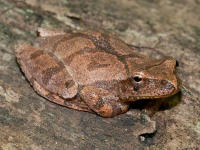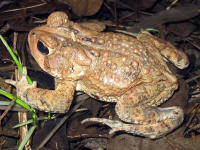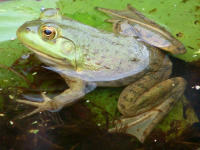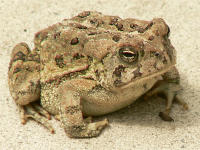March 25.
6 A. M. To Brister's Hill.
The Fringilla hyemalis sing most in concert of any bird nowadays that I hear. Sitting near together on an oak or pine in the woods or an elm in the village, they keep up a very pleasant, enlivening, and incessant jingling and twittering chill-lill-lill, so that it is difficult to distinguish a single bird's note, – parts of it much like a canary.
This sound advances me furthest toward summer, unless it be the note of the lark, who, by the way, is the most steady singer at present. Notwithstanding the raw and windy mornings, it will sit on a low twig or tussock or pile of manure in the meadow and sing for hours, as sweetly and plaintively as in summer.
I thought I heard the note of a robin and of a bluebird from an oak. It proceeded from a small bird about as big as a bluebird] which did not perch like a woodpecker, uttering first some notes robin-like or like the golden robin, then perfect bluebird warbles, and then it flew off with a flight like neither. [Was it not the fox-colored sparrow?] From what I saw and heard afterward I suspected it might be a downy woodpecker.
I see fine little green beds of moss peeping up at Brister's Spring above the water.
When I saw the fungi in my lamp, I was startled and awed, as if I were stooping too low, and should next be found classifying carbuncles and ulcers. Is there not sense in the mass of men who ignore and confound these things, and never see the cryptogamia on the one side any more than the stars on the other? Underfoot they catch a transient glimpse of what they call toad stools, mosses, and frog-spittle, and overhead of the heavens, but they can all read the pillars on a Mexican quarter.
They ignore the worlds above and below, keep straight along, and do not run their boots down at the heel as I do.
How to keep the heels up I have been obliged to study carefully, turning the nigh foot painfully on side-hills.
I find that the shoemakers, to save a few iron heel-pegs, do not complete the rows on the inside by three or four, — the very place in the whole boot where they are most needed, — which has fatal consequences to the buyer. I often see the tracks of them in the paths. It is as if you were to put no underpinning under one corner of your house.
I have managed to cross very wet and miry places dry-shod by moving rapidly on my heels. I always use leather strings tied in a hard knot; they untie but too easily even then.
Those willow cones appear to be galls, for, cutting open one of the leafy ones, I found a hard core such as are often seen bare, the nucleus of the cone, and in it a grub. This gall had completely checked the extension of the twig, and the leaves had collected and over flowed it as the water at a dam. Perchance when the twig is vigorous and full of sap the cone is leafy; other wise a hard cone.
11 A. M. – To Framingham.
A Lincoln man heard a flock of geese, he thinks it was day before yesterday.
Measured a white oak in front of Mr. Billings's new house, about one mile beyond Saxonville,-twelve and one twelfth feet in circumference at four feet from the ground (the smallest place within ten feet from the ground), fourteen feet circumference at ground, and a great spread.
Frank's place is on the Concord River within less than ten miles of Whitehall Pond in Hopkinton, one of [the sources], perhaps the principal source, of the river. I thought that a month hence the stream would not be twenty feet wide there.
Mr. Wheeler, auctioneer, of Framingham, told me that the timber of the factory at Saxonville was brought by water to within about one mile of where the mill stands. There is a slight rapid.
Brown says that he saw the north end of Long Pond covered with ice the 22d, and that R. W. E. saw the south end entirely open.
The winter rye greens the ground.
H. D. Thoreau, Journal, March 25, 1853
The Fringilla hyemalis sing most in concert of any bird nowadays that I hear. See March 22, 1859 (" I hear the lively jingle of the hyemalis and the sweet notes of the tree sparrow. . .. Both species in considerable numbers, singing together as they flit along, make a very lively concert. They sing as loud and full as ever now. "); March 23, 1852 ("I heard, this forenoon, a pleasant jingling note from the slate-colored snowbird on the oaks in the sun on Minott's hillside. Apparently they sing with us in the pleasantest days before they go northward"); March 28, 1854 ("A flock of hyemalis drifting from a wood over a field incessantly for four or five minutes, — thousands of them, notwithstanding the cold."); April 8, 1854 ("Methinks I do not see such great and lively flocks of hyemalis and tree sparrows in the morning since the warm days, the 4th, 5th, and 6th. Perchance after the warmer days, which bring out the frogs and butterflies, the alders and maples, the greater part of them leave for the north and give place to newcomers") See also A Book of the Seasons by Henry Thoreau, the Dark-eyed Junco (Fringilla hyemalis) and A Book of the Seasons, by Henry Thoreau, Signs of the Spring, the note of the dark-eyed junco going northward
I see the white-breasted nuthatch, head downward . . . his rapid and, as it were, angry gnah gnah gna, and a faint, wiry creaking note See March 25, 1859 ("I heard the what what what what of the nuthatch this forenoon. It is much like the cackle of the pigeon woodpecker."); March 25, 1856 (“There have been few if any small migratory birds the past winter. I have not seen a tree sparrow, nuthatch, creeper, nor more than one redpoll since Christmas. ”) See also note to March 5, 1859 ("Going down-town this forenoon, I heard a white-bellied nuthatch on an elm within twenty feet, uttering peculiar notes and more like a song than I remember to have heard from it. . . .It was something like to-what what what what what, rapidly repeated, and not the usual gnah gnah; and this instant it occurs to me that this may be that earliest spring note which I hear, and have referred to a woodpecker!. . . It is the spring note of the nuthatch”) and A Book of the Seasons, by Henry Thoreau, The Nuthatch and A Book of the Seasons, by Henry Thoreau, Signs of the Spring :The Spring Note of the Nuthatch
Several little groves of alders on which I had set my eye had been cut down the past winter. See March 22, 1853 ("The very earliest alder is in bloom and sheds its pollen. I detect a few catkins at a distance by their distinct yellowish color. This the first native flower"); March 23, 1853 ("The alder catkins, just burst open, are prettily marked spirally by streaks of yellow, contrasting with alternate rows of rich reddish-brown scales, which make one revolution in the length of the catkin."); March 26, 1853 ("There is a large specimen of what I take to be the common alder by the poplar at Egg Rock, five inches in diameter. It may be considered as beginning to bloom to-day."); March 26, 1857 ("The first croaking frogs, the hyla, the white maple blossoms, the skunk-cabbage, and the alder’s catkins are observed about the same time.") See also A Book of the Seasons, by Henry Thoreau, The Alders and A Book of the Seasons, by Henry Thoreau, Signs of the Spring: Alder and Willow Catkins Expanding
I always use leather strings tied in a hard knot; they untie but too easily even then. See July 25, 1853 ("I have for years had a great deal of trouble with my shoe-strings, because they get untied continually . . . One shoemaker sold us shoe strings made of the hide of a South American jack ass, which he recommended; or rather he gave them to us and added their price to that of the shoes we bought of him. But I could not see that these were any better than the old."); August 5, 1855 ("It seems that I used to tie a regular granny’s knot in my shoe-strings, and I learned of myself —rediscovered—to tie a true square knot, or what sailors sometimes call a reef-knot. It needed to be as secure as a reef-knot in any gale, to withstand the wringing and twisting I gave it in my walks.")
A Lincoln man heard a flock of geese, he thinks it was day before yesterday. See March 24, 1859 ("C. sees geese go over again this afternoon. How commonly they are seen in still rainy weather like this!"); March 27 and 28, 1860 ("Louis Minor tells me he saw some geese about the 23d."); March 27, 1857 ("Farmer says that he heard geese go over two or three nights ago."); See also A Book of the Seasons, by Henry Thoreau, Signs of the Spring; Geese Overhead
The red maple buds already redden the swamps and riverside. See March 28, 1852 ("The smoky maple swamps have now got a reddish tinge from their expanding buds."); April 1, 1860 ("The red maple buds are considerably expanded, and no doubt make a greater impression of redness."); April 10, 1853 (''The male red maple buds now show eight or ten (ten counting everything) scales, alternately crosswise, and the pairs successively brighter red or scarlet, which will account for the gradual reddening of their tops."); April 13, 1854 ('I begin to see the anthers in some buds. So much more of the scales of the buds is now uncovered that the tops of the swamps at a distance are reddened."); April 24, 1857 ("I see the now red crescents of the red maples in their prime . . . above the gray stems."); April 26, 1855 ("The blossoms of the red maple (some a yellowish green) are now most generally conspicuous and handsome scarlet crescents over the swamps. “); April 26, 1860 ("I have noticed their handsome crescents over distant swamps commonly for some ten days.."); April 29, 1856 ("Sat on the knoll in the swamp, now laid bare. How pretty a red maple in bloom (they are now in prime), seen in the sun against a pine wood, like these little ones in the swamp against the neighboring wood, they are so light and ethereal, . . .and they are of so cheerful and lively a color.") See also A Book of the Seasons, by Henry Thoreau, The Red Maple
















